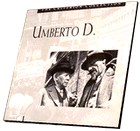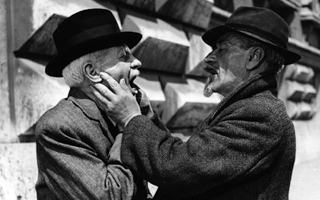

Italy film school
1955
bw 90 min.
Director: Vittorio De Sica
CLV: $49.95 - available
1 disc, catalog # CC1214L
VHS: available from Home Vision Cinema

Commercial Italian
filmmakers of the early post-war era didn't put much stock in the few crews
shooting movies in the streets of Rome and Naples, casting local plumbers,
masons, and slum children in plum roles. These "neo-realists" made gritty,
scaled-down films that took the problems of contemporary life head-on, but
what profit could there be in airing Italy's dirty secrets when it seemed
(rightly) that prosperity was just around the corner?But Vittorio De Sica,
Luchino Visconti, and Roberto Rossellini sought a cinema of conscience and
eschewed the gaudy costume dramas, historical epics, and propaganda films
that constituted the bulk of Italy's production. Their mission was best
described by one of neo-realism's lesser-known practitioners, Alberto
Lattuada, who wrote in 1945: "So we're in rags? Then let us show our rags to
the world. So we're defeated? Then let us contemplate our disasters. So we
owe them to the Mafia? To hypocrisy? To conformism? Then let us pay our
debts with a fierce love of honesty, and the world will be moved to
participate in this great combat with truth. The confession will throw light on
our hidden virtues, our faith in life, our immense Christian brotherhood. We
will at last meet with comprehension and esteem. The cinema is unequaled
for revealing all the basic truths about a nation."
De Sica's Umberto D.
is widely considered a masterwork of this principled movement, an elegant if
bleak film that stands with Bergman's Wild Strawberries as one of the
great portraits of old age and loneliness ever brought to the screen. But there
is a tenderness in De Sica's film that the colder Bergman cannot manage. De
Sica hoped to give "the story of the old retired office worker, his tragic
solitude, his boundless sadness, and his pathetic awkward attempts at
warming his heart, a kind of universality that would be understood by
everyone." Unfortunately the film was greeted with critical indifference,
disastrous box-office returns, and hostility from the Italian government,
which subsequently banned the export of films deemed unflattering to
Italian society. It was in the foreign market that the neorealists made their
name. De Sica's early masterpiece, The Bicycle Thief (1948), which
defined the aims and ideals of the movement, using non-professional actors
and actual locations, had been met with enormous critical enthusiasm both in
the U.S. and in Europe; it still stands as a hallmark of Western cinema. And
when Umberto D. was released in the U.S., it won the 1955 New York
Film Critics Award for Best Foreign Film as well as an Oscar nomination for
screenwriter Cesare Zavattini's story.
Zavattini was a literary
jackof-all-trades: a journalist, editor, writer for children's magazines, and
novelist. In the thirties he wrote his first film scripts, including a pleasant
comedy called I'd Give a Million (1935), which starred a young comic
actor named Vittorio De Sica as a millionaire who dreams of giving away all
his money. While the film was a modest success, its true claim to honor is
that it brought Zavattini and De Sica together for the first time.
In film lore
the two have become virtually inseparable. Their collaborations comprise
The Children are Watching Us (1943), Shoeshine (1946), The
Bicycle Thief (1952), Miracle in Milan (1951), Umberto D.
(1952), and Stazione Termine (1953) -- every one but the last a
keystone of neo-realism. Their work on Umberto D. moved the French
critic André Bazin to call the film "a masterpiece which film history is
certainly going to grant a place of honor." His prediction has indubitably been
borne out.
Since its initial release, the film has roused critics, particularly
for its use of real-time sequences. The long, patient takes cinematographer
Aldo Graziati (a.k.a. G. R. Aldo) lavishes on the maid's morning ritual or
Umberto's hopeless effort at getting to sleep are practical lessons in the
neo-realist vision: scrupulously untheatrical moments in which real life is
being lived, for better or worse, by real people.
Graziati is little known, but
his work is extraordinary. After an outstanding career as a studio cameraman
in Paris, shooting films for Carné and Cocteau, director Michelangelo
Antonioni introduced him to Visconti and De Sica. From 1948 until 1953,
when he was killed in a car crash on the Padua-Venice autostrada while
working on Visconti's Senso, Graziati's camera became the eye of
neo-realism.
De Sica, Zavattini, and Graziati all hold places of distinction in
this unique cinematic brotherhood that forever changed the way films would
be made. "We sought to redeem our guilt," De Sica said, looking back on the
movement he helped to begin. "We strove to look ourselves in the eyes and
tell ourselves the truth, to discover who we really were, and to seek
salvation." Like poor Umberto.
-- PETER
BECKER
Credits
Director: Vittorio De Sica
Producer: Nino
Misiano
Screenplay: Cesare Zavattini, Vittorio De Sica
Photographed by:
G.R. Aldo
Edited by: Eraldo di Roma
Music by: Alessandro
Cicognini
Production Designer: Virgilio
Marchi
Transfer
This edition of Umberto D. was
transferred from a 35mm master print.




